| This is part five of a six-part series examining supposed evidences for a global flood that have recently appeared on the Answers in Genesis web site. |
| The people at AiG are my brothers and sisters in Christ, and I share their love for the Lord Jesus Christ, their respect for the Bible as the Word of God, and their desire to see people come to faith in Christ. However, I view their arguments for a young Earth and geological catastrophism as unnecessary Biblically, as poor apologetics, and as a serious obstacle to the evangelism of scientists. |
| Unfortunately, few people in our churches or Christian education system have the geological background to critically analyze these arguments. The result is that people read articles like these from AiG, find them to be rather impressive, and believe that these present sound arguments in defense of the Bible. The opposite, however, is true. A vast majority of Christian geologists find the arguments for a young Earth and the geologic work of the Flood to be untenable. It is my strong opinion that the young-Earth arguments of young-Earth creationist organizations like AiG have no place in our churches and Christian education system. |
| Part one examined the young-Earth creationist (YEC) argument that fossils at high elevations are proof of a global flood. |
| Part two examined the YEC argument that sedimentary rocks that contain dense accumulations of fossils can best be described by the action of Noah’s Flood. |
| Part three examined the YEC perception that transcontinental rock layers, such as the sandstone layer that is found at the base of the Paleozoic sediments throughout much of North America, can best be explained by Noah’s flood. |
| Part four looked at the YEC claim that long-distance transport of sand grains can only be explained by Noah’s flood. |
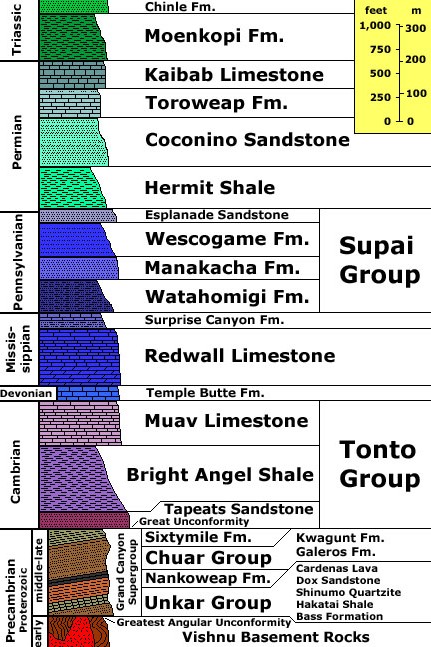
“Flood evidence number five” from Answers in Genesis is called “No Slow and Gradual Erosion.” Young Earth geologist Dr. Andrew Snelling begins this article with a major overstatement:
“Today we see the effects of weathering and erosion all around us. But where is the evidence of millions of years between rock layers? There is none.”
To say that there is no evidence for extensive weathering and erosion in the geologic column is simply not true.
The geologic record is comprised not only of rocks formed by deposition of sediments, but also by the gaps between these rock layers which represent times of non-deposition or erosion. In order to make his case that there is no evidence for long periods of weathering and erosion in the geologic record, Snelling looks at four examples of contacts between formations in the Grand Canyon, while ignoring perhaps the greatest example of weathering in the canyon’s sedimentary rock layers. In each of these cases, the standard geological interpretation is that there was a period of time—in some cases over 100 million years—between the deposition of these formations. Snelling attempts to show that deposition of these units occurred during Noah’s flood, with only minimal time gaps between the formations.
Snelling uses the following examples:
1. The contact between the Cambrian Tapeats Sandstone and the underlying Precambrian rocks.
The Precambrian rocks at the base of the Grand Canyon include layered sedimentary rocks (see picture below) as well as metamorphic rocks. These were eroded to a flat surface before the Tapeats Sandstone was deposited (the Tapeats was discussed back in part 3 of this series).
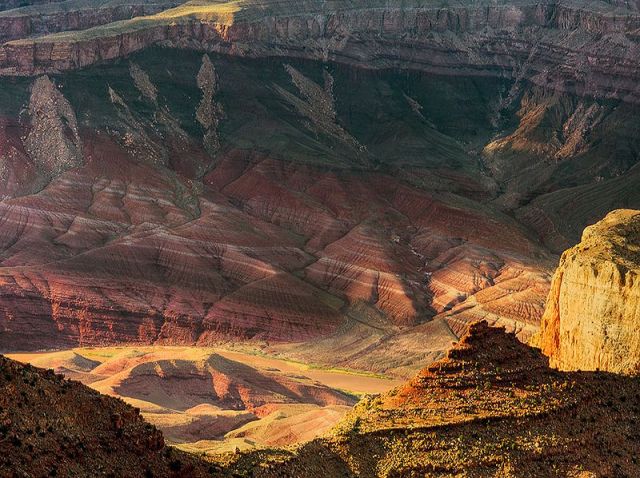
According to Snelling, there is no evidence for weathering (e.g. soil formation) on the Precambrian surface.
Response:
- It may be true that no paleosols (ancient soil layers) have been found beneath the Tapeats in the Grand Canyon, but certainly the deposition, lithification (process of turning sediment into stone), and tilting of the Precambrian sedimentary rocks and their subsequent beveling off took some time and involved erosional processes. Some young-Earth creationists would claim that these Precambrian rocks are pre-Flood deposits, but it should be noted that they contain some fossils, such as stromatolites and even possible jellyfish.
- If the Flood had eroded the Precambrian (pre-Flood rocks in the young-Earth scenario), we should expect to see a very uneven surface. The basement rocks (Vishnu Schist and associated granitic rocks) would be very resistant to erosion and should have formed topographic highs. The Precambrian sedimentary rocks would have had varying levels of resistance to erosion, and should have formed a series of ridges and valleys, with the more-resistant layers forming the ridges. It is difficult to visualize a global flood creating a flat surface like what is observed.


- There is a modern analog for a flat surface on Precambrian rocks. The Canadian Shield is a vast region covering much of eastern Canada as well as portions of northern Minnesota and Wisconsin. It is composed of hard metamorphic and igneous rocks, which once formed the roots of mountain ranges. The Canadian Shield illustrates that erosional processes can reduce even the most resistant rocks to a level surface. (The Canadian shield is not perfectly flat, of course, though relief in most of the region is low. It was likely considerably more planar before being scraped by glaciers repeatedly during the Pleistocene Ice Ages.)
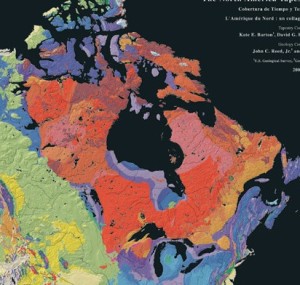
- There may not be paleosols (soil horizons) developed on the Precambrian rocks in the Grand Canyon, but they are present elsewhere, such as the contact between Precambrian basement rocks and the Cambrian Lamotte Formation in Missouri.
2. The contact between the Mississippian Redwall Limestone and the underlying Devonian Temple Butte Formation and Cambrian Muav Limestone.
Snelling correctly observes that the top of the Muav contains what appear to be erosional channels, some of which are filled with the material that makes up the Temple Butte Formation. However, Snelling dismisses these as evidence for stream erosion, preferring to interpret these channels as having been caused by the Flood.
Snelling goes further to claim that the Redwall and Muav show signs of interbedding. The contacts between some rock units are distinct. For example, higher in the geologic column, there is a distinct point where the Hermit Shale ends and the Coconino Sandstone begins (see #4 below). There is no mixing of any sort between the two.

Not all contacts between formations are this sharp; some are considerably more transitional. Interbedding is a type of transition where there are alternating beds of the upper and lower formations, so rather than going directly from formation A to formation B, the transition might go A-B-A-B-A-B.
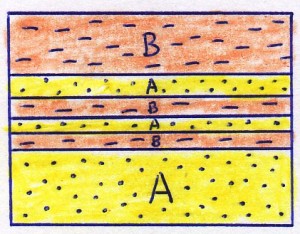
The two preceeding diagrams represent what one might see in an individual outcrop. Over greater distances—tens or even hundreds of kilometers—the situation might look more like this:
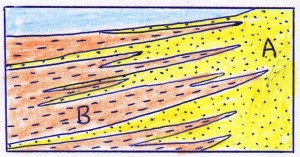
This could represent a migrating shoreline as the sediments pile up, with unit A being deposited further to the right at some times, and further to the left at others. An important part of this concept is that A and B are being deposited at the same time, one closer to the shoreline, and one further out.
If the Muav and Redwall were truly interbedded, it would be a major challenge to accepted interpretations. The Muav is Cambrian, and the Redwall is Mississippian, so there should be over 100 million years of non-deposition or erosion represented by the boundary between the two. If they are interbedded, this would imply that they were being deposited at the same time.
Response:
- The channels beneath the Redwall appear to be real stream channels, though as far as I know this cannot be conclusively demonstrated at this time.
- The Temple Butte Limestone fills these channels. Paleontological evidence suggests that this is a freshwater limestone. How did this happen during a global salt-water flood?
- A diagram of the supposed interbedding is shown here (figure 3). The blotchy nature of the contact between what the authors call the Muav and what they call the Redwall looks like a secondary, post-depositional feature (diagenetic) rather than a primary, depositional feature. This could have been formed by groundwater at any time after the deposition of the Redwall Limestone. If this were true interbedding, it certainly would have been puzzled over by many a geologist hiking along the very popular North Kaibab Trail in the Grand Canyon.
3. The contact between the Permian Hermit Shale and the underlying Pennsylvanian Esplanade Sandstone.
Snelling claims that interbedding of the Hermit and Esplanade proves that there was not millions of years between their deposition.
Response:
- This may be a case where interbedding is legitimate; they could represent adjoining sedimentary environments, at least for a time. There is not a huge time gap between the two formations.
- The erosional relief on top of the Esplanade is up to 16 m (60 ft), which appears to be the result of stream erosion. (USGS Geologic Investigations Series I–2688). Snelling doesn’t mention this.
- Paleontological and petrologic (rock) evidence indicates that both of these units were formed in swampy environments, not in a global flood.
4. The contact between the Coconino Sandstone and the underlying Hermit Shale, both of Permian age.
In the previous two examples, Snelling says the boundaries between formations appeared to be too diffuse to represent vast gaps in geologic history. The Coconino-Hermit boundary, on the other hand, appears to Snelling to be too sharp.
Response:
- The Coconino is a wind-deposited sandstone, with terrestrial arthropod and reptile tracks, as well as animal burrows. What were paleo-lizards doing running around on the sand in the middle of the flood? By itself, this ought to rule out a flood explanation for the Coconino.
- In an increasingly arid environment, it should not be surprising that there is little in the way of stream channel erosion or soil development beneath the Coconino.
Snelling completely ignores two compelling pieces of evidence for long periods of weathering and erosion in geologic history:
1. Paleosols — I have briefly referred to paleosols (ancient soils) already. The formation of a soil on top of bare rock or sediment takes a combination of physical weathering, chemical weathering, biological processes, and time, and is a process that normally takes thousands of years. If paleosols exist within the geologic record, they are strong evidence that there were long periods of time when rocks or sediments were exposed on the surface to the atmosphere.
My graduate research was in the Palouse Loess of Eastern Washington, which contains multiple, stacked paleosols. Each of these paleosols contains soil horizons identical in character to modern soil profiles in the area, complete with root casts and animal burrows. Each paleosol would have taken several hundred or even thousands of years of surface stability to form, only to be buried by an influx of wind-blown silt, setting the stage for the next time of soil formation. The Palouse Loess is a Quaternary formation, and young-Earth creationists would say that this was formed after the Flood.
I did a quick search in the Geological Society of America Bulletin, and came up with the following articles describing paleosols in Paleozoic and Mesozoic rocks:
- δ13C depth profiles from paleosols across the Permian-Triassic boundary: Evidence for methane release
- Greenhouse crises of the past 300 million years
- Paleokarst, paleosol, and rocky-shore deposits at the Mississippian-Pennsylvanian unconformity, northwestern Arkansas
- High latitude meteoric δ18O compositions: Paleosol siderite in the Middle Cretaceous Nanushuk Formation, North Slope, Alaska
- Paleoclimatic inferences from paleopedology and magnetism of the Permian Maroon Formation loessite, Colorado, USA
This is from just one journal; there are undoubtedly thousands of documented paleosols in the geologic record. A majority of the articles I found were about Cenozoic paleosols, but I ignored these for brevity and also because many young-Earth creationists describe Cenozoic rocks as being post-Flood (a position which has just about as many problems as the rest of young-Earth creationism).
2. Paleokarst — Karst topography is formed by the dissolution of carbonate rocks, such as limestone. Features of karst topography include caves, sinkholes, and disappearing streams.

Karst topography is common in areas underlain by limestone, and one would expect that this would have been the case throughout geologic history. Snelling completely ignores the greatest evidence for weathering and erosion in the Grand Canyon, and this is the paleokarst (ancient karst) that exists in the Redwall Limestone. Snelling wrote about the bottom of the Redwall, but not its top! The Redwall appears to have all the features of karst topography, such as rubble (breccia) filling sinkholes, and a chaotic upper surface.
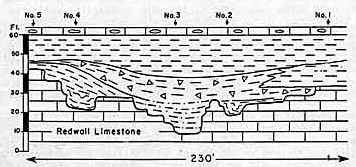
Karst topography on top of the Redwall implies that there was a considerable amount of time when the consolidated limestone—as opposed to fresh limey sediments—was exposed to the atmosphere, with freshwater circulating through the rocks. This could not have happened in the context of a global flood.
Additional problems for the flood-geology/young-Earth position:
Many of the features I have described are difficult to explain within the young-Earth model for Earth history. These include ancient soil layers, ancient karst systems, and the difficulty of producing the flat surface that underlies the Cambrian in the Grand Canyon.
Young-Earth creationists seem to acknowledge that the geologic record contains evidence of periods of non-deposition and erosion, as well as periods of deposition. The difference would be a matter of time scales. Geologists are willing to talk about periods of millions of years, whereas young-Earth creationists have to squeeze these events into periods of hours or days.
What sort of erosion would occur in a global flood? The young-Earth literature implies that the flood began with an intense period of erosion, with forces powerful enough to pulverize granite. It seems that this continued in various places throughout the flood. Would we not expect, therefore, that a significant feature of the geologic record would be mega-scouring of soft sediments? Snelling refers to something called “sheet erosion” which conveniently doesn’t scour soft sediments. I don’t think he can have it both ways: sufficiently strong to shatter granite, but gentle enough to produce smooth surfaces on mud and sand.
There are numerous other indicators of a passage of time within the rock record. These include vertebrate (amphibian, reptile) nests, which imply a time when the land was sufficiently dry for a long enough time to allow mating, nest-building, and rearing of young (at least some dinosaurs cared for their young). This could not have happened in the middle of the Flood. Other shorter-term indicators of periods of non-deposition include worm burrows, raindrop impressions, and mudcracks, all of which are common.
Conclusion:
There is considerable evidence in the geologic record for long periods of slow, gradual weathering and erosion. Paleosols represent periods of stability, when sediments or rocks were exposed to the atmosphere for long periods of time. These ancient soils include features such as plant roots and animal burrows. The contacts between sedimentary formations represent periods of erosion or non-deposition, and often are somewhat irregular, being cut by stream channels. In other places, limestone formations show signs of having been exposed to freshwater groundwater circulation, resulting in paleokarst.
As with the other “flood evidences,” this one turns out to be completely inadequate as an explanation for how the Earth got to be the way it is. Because of this, Flood Evidence #5 ought not to be used in defense of the truthfulness of God’s holy word, the Bible.
Up next: Flood Evidence #6: Rock Layers Folded, Not Fractured.
With love for the body of Christ.

The proverb applies to both sides of an argument: “The first to present his case seems right, till another comes forward and questions him.”
Do you have any idea how someone from AiG, such as Snelling or Garner, would respond to what you brought up here? My knowledge of geology is limited and to some extent I have to just accept the words of the experts as stated. Having a back and forth would help people like me.
LikeLike
I would love to see some more interaction from the YECs on this series as well. I know they have addressed the question of paleokarst in the Redwall Limestone elsewhere; I was just surprised with how Snelling chose to completely ignore one of the best examples of weathering in the Grand Canyon.
They would say that examples of paleokarst and paleosols in the geologic record are really something else.
They might say that the Canadian Shield is not a really good analog for a basement surface that has been eroded flat, as it is not flat enough (although I read an article yesterday that said the relief on the top of the Grand Canyon Precambrian is greater than I realized: ridges with up to 240 m of relief beneath the Tapeats — Flood Geology and the Grand Canyon: A Critique by Hill and Moshier).
LikeLike
Re the Surprise Canyon Formation, in “Grand Canyon Monument to Catastrophe” (1994), Dr. Steve Austin states “More study needs to be conducted on this formation.” From what I can tell, since then he has since devoted most of his time on the R.A.T.E. effort (which is full of huge flaws) and studying Nautiloid fossils in a small six foot layer at the bottom of the Redwall Limestone. I have been going through back issues of the Creation Science Research Quarterly (CRSQ) and no YEC has tackled the issue in that publication. The recently published “Your Guide to the Grand Canyon A Different Perspective” by Tom Vail, Michael Oard, Dennis Bokovoy, and John Hergenrather completely ignores the Surprise Canyon Formation except that it appears (barely) in a photo of a model of the Grand Canyon geologic column taken at the visitors center. A YEC drawing of the Grand Canyon geologic column appearing on another page of the book completely ignores the formation.
By far the best research on the Surprise Canyon Formation is contained in “Geology of the Surprise Canyon Formation of the Grand Canyon, Arizona,” Museum of N. Arizona Bulletin 61, 1999. It can be ordered through the Museum of Northern Arizona.
I suppose the YEC could say they’re ignoring the Surprise Canyon Formation because it can only be seen in the western Grand Canyon, but that’s not true. It rings around Horseshoe Mesa, which can be accessed rather easily (as Canyon trails go!) on the Grandview Trail.
LikeLike
Brother – If the Hebrew in Genesis means what it means, then the text indicates Creation happened in an actual week. Genesis also makes clear that death is the product – wages, if you will – of man’s sin. Any Old Earth model requires that Adam was created after death had already come into the world. Either man is the product of death or death is the product of man. The rest of the Bible makes your position untenable. The Ten Commandments refer to the the creation week as six literal days, as the model for man’s work week. Jesus himself refers to Genesis repeatedly as actual history, referencing Abel, Noah, and the flood among other things. There is no reference in the New Testament to his making an attempt to correct or ammend the assumption that Genesis was to be taken other than as his audience clearly understood it. You claim to be my brother in Christ, and so I take you as that. Can you not see how the Gospel of our Lord, not to mention His very intellectual integrity, mandates that Genesis cannot be read as some problematic allegory for a model that includes evolution? If there were death before sin, then the wages of sin is not death and the death of an incarnate God is not the antidote for it. Old Earth models, be they a variety of the gap theory, progressive creationism, day age theory, or framework hypothesis are not only Biblically nonsensical, but they render the good news of Jesus’ sacrifice on the cross irrelevant.
Dave
LikeLike
@David Hollis
Now I am not a Hebrew or Greek scholar and my theological training is limited, so I do not profess to be an expert on these matters. But I put forward my hesitant view of the subject nonetheless. From what I’ve seen, there are a number of orthodox* ways of interpreting the creation narrative that maintain an old earth but would still have physical death entering with the Fall. However I don’t think that that is even entirely needed. When death is talked about in Genesis 2-3 and Romans 5 it seems to me that from the context it is talking about spiritual death, that is separation from God which is well worse than physical death. Now don’t get me wrong, physical death is what causes the ultimate, eternal separation from God if you do not place your trust in Jesus Christ. But the Fall was immediate and the day Adam ate of it he suffered death: separation from God, that could only be redeemed through atonement and sacrifice and eventually the sacrifice of Jesus.
I do not think that a belief in an old earth or even theistic evolution or for that matter even young earth creationism renders the good news of Jesus’ sacrifice irrelevant. He really did conquer the last enemy that day on the cross, but unless we see his second coming we will still face physical death, but we will not have to face an eternity without God in spiritual death if we have put our hope in the hope of the cross, thank goodness.
*your mileage varies, obviously, when it comes to what someone else or even a general consensus deems orthodoxy, one man’s orthodoxy is another’s heresy…
LikeLike
David Hollis:
Thanks for your comment, and I appreciate your desire to be true to the Word of God. I share that high view of Scripture.
Most of the issues you brought up I have addressed elsewhere on The GeoChristian. Overall, it is the young-Earth creationists who go beyond what is actually written in the Bible, and then expect the rest of us to go along.
1. Old-Earth creationism only requires animal death before the fall. None of the passages used by YECs to demonstrate that there was no animal death before the fall, such as Gen 3, Rom 5, and Rom 8, say anything whatsoever about animal death. I have written about this in more detail here.
2. The word “day” in Exodus 20:11 (“For in six days the Lord made the heavens and the earth…”) means the same thing it does in the opening passage of Genesis, and “day” is used figuratively at least once in the Genesis creation passages (Gen 2:4). If it has a figurative or symbolic meaning in Genesis, it can have the same meaning in Exodus 20.
3. Jesus referred to Genesis as history. So do old-Earth creationists.
4. How did the original audience understand Genesis? Probably in ways that we have a difficult time understanding, as there is symbolism there that we completely miss. It was written in the context of second century BC Near Eastern society, with its covenantal and temple rituals. I’m not saying that there were pagan influences in the writing of Genesis, but that there was a certain cultural background that the Hebrews had that we can only get glimpses of. When I read about the creation of the sun, moon, and stars, I think of it in terms of the creation of physical objects in our galaxy. The Hebrews read this in the context of pagan religions who worshiped the sun, moon, and stars. Did they see everything that modern YECs read into creation or the flood? I don’t think so, but that doesn’t stop YEC speculation about vapor canopies, dinosaurs in the Garden, and changes in the speed of light.
5. I don’t read Genesis as an allegory. I also try to not make it say things that aren’t there, such as accelerated nuclear decay, a global tropical climate, and hyper-rapid evolution after the flood.
6. The wages of sin is death. Amen. Adam and Eve died spiritually when they took of the fruit, and eventually died physically in the absence of the Tree of Life.
7. As an old-Earth creationist, I believe in a real creation by the Triune God, in a real Adam, in a real Garden, in a real fall into sin, in real consequences for that sin, and in Jesus Christ as the only solution for that sin through his death on the cross as my substitute. Belief in an old universe does nothing to compromise the gospel.
8. “You claim to be my brother in Christ, and so I take you as that.” But you are not quite sure because I don’t buy into young-Earth creationism. Are you adding something to the gospel?
Grace and Peace,
Kevin N
LikeLike
I noticed your using some Lutheran links i am a wisconsin synod lutheran if one of our pastors rejected a young earth we would get rid of him Hopefuly the lc-ms which link you use still also would.
LikeLike
Hi Robert,
I grew up in the ELCA, but am now in the Evangelical Free Church. I describe myself as an evangelical who leans more towards Luther than Calvin. I appreciate much that comes out of confessional Lutheranism; hence my link to the Cranach blog over in the right-hand column and frequent Luther quotes. I have a link to Issues Etc because it is one of the best programs on Christian Radio (except when the guest is Ken Ham).
I am sorry that you would automatically “get rid of” a pastor who didn’t preach the young-Earth line. If you look at my recent Creation Creeds post you will see that rejection of young-Earth creationism doesn’t lead to a compromise of any core Christian doctrines.
For me, the WELS and LCMS alliance with the young-Earth creationists is a barrier. It is not difficult to show that YEC is neither Biblically necessary nor scientifically valid.
Thanks for your comment.
LikeLike
Pingback: De anomalieën van Stichting Oude Wereld (II) - Gevormd uit Sterrenstof
Pingback: Six bad answers to questions raised in Genesis are still six bad answers « Fr. Orthohippo
I appreciate your knowledge and your user if the talents that God has given you. I personally don’t care which side is right on this issue, because this is not the crux of Christianity. However, I am interested in what your interpretation of the Biblical flood is. What do you think it was? Do you believe it was as the Bible describes? Or do you think it was something else?
Thanks,
Toby
LikeLike
Toby — I’ve been rather busy and apologize that I don’t have much time to answer your question. Here are a few things I’ve written about Noah’s flood:
https://geochristian.com/2013/05/19/geoscriptures-genesis-6-9-reading-the-account-of-noahs-local-flood/ — Genesis 6-9 is more ambiguous on the extent and work of Noah’s flood than young-Earth creationists would have us believe.
https://geochristian.com/2013/03/11/geoscriptures-genesis-719/ — In the Bible, “all the earth” usually does not mean “all the earth.”
https://geochristian.com/2009/10/06/six-bad-arguments-from-answers-in-genesis-part-6/ — The best young-Earth geological arguments for Noah’s flood are full of problems and should not be used to support the reliability of the Bible.
https://geochristian.com/2011/01/29/the-esv-study-bible-on-creation-noahs-flood/ — Many theologically conservative Bible teachers believe the Bible does not require a world-wide flood, as reflected in the notes of the ESV Study Bible.
LikeLike
Geo-
I appreciate the links and will take a look at them. Recently I have looked deeper into translations and modern accepted dogma. It’s pretty interesting how widely accepted ideas could not be the intent.
I wholeheartedly agree with you that this is a secondary issue and that knowing Christ is the most important. Thank you for your work. I also agree that this is a sticking point for many, as I have had a few conversations about creation with atheists that revolve around scientific “facts” vs. the Bible. As long as your ministry doesn’t conflict with the Bible, press on brother.
Thank you for making science accessible to those, like me, who are not scientists by trade.
God bless,
Toby
LikeLike
Pingback: Buried rivers kill Noah’s Flood « The League of Reason Blog
Pingback: Redwall karst | Altenoweb